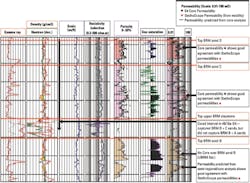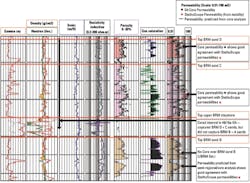First ever release of USGS offshore arctic resource assessment
Alaska Platform, South Kara Sea have greatest potential
To provide a perspective on the arctic resource potential, the US Geological Survey (USGS) recently assessed the undiscovered oil and gas resources north of the Arctic Circle. The Circum-Arctic Resource Appraisal (CARA) includes probabilistic estimates of the numbers, sizes, and aggregate volumes of yet-to-find oil, gas, and natural gas liquids in undiscovered accumulations (Gautier et al. 2009). The initial paper recognizes that most undiscovered resources probably would be found on the continental shelves, but this publication inOffshore is the first release of the CARA estimate of onshore versus offshore allocation of undiscovered resources.
The offshore arctic is roughly equal parts deep ocean basin and continental shelf covered by less than 500 m (1,640 ft) of water. The geology of the deep basins suggests limited petroleum potential, but the continental shelves include some of the largest untested prospects on Earth. Only a handful of wells have been drilled offshore, but these have found numerous oil and gas accumulations, including Snøvit field in the Norwegian Barents Sea and the supergiant Shtokman field in the Russian Barents Sea.
In spite of these successes, remoteness and technical difficulty severely restrict offshore activity, so most of these offshore discoveries remain undeveloped.
USGS assessment
The CARA was a geology-based, probabilistic study of the potential for new discoveries north of the Arctic Circle of conventional oil and/or gas in accumulations larger than 50 MMbbl of oil or 300 bcf of natural gas. So-called unconventional resources such as coal bed methane, heavy oil and bitumen, and gas hydrates are not evaluated.
North Polar view of the arctic showing offshore areas of CARA Assessment Units color-coded for mean natural gas estimates.
As petroleum is found almost exclusively in sedimentary rocks, the first step in assessment was to construct a consistent map of the arctic sedimentary basins, delineated according to geologic age, tectonic history, thickness of sedimentary strata, and structural style (Grantz et al. 2009). The new map helped subdivide the arctic into geologically defined subsets called Assessment Units (AUs). Sixty-nine AUs were defined based on the new mapping; their boundaries are available online (USGS 2009).
The fundamental question of petroleum potential is whether the mapped AUs contain undiscovered oil and gas. Based on geological criteria, each AU was evaluated for the likelihood (the marginal probability) of occurrence of at least one undiscovered accumulation larger than the 50 MMboe minimum accumulation size, in comparison to all other AUs of the arctic and to similarly defined AUs worldwide. Those AUs with proven discovery histories, such as the Alaska Platform, which includes Prudhoe Bay and many other petroleum accumulations, were assigned a marginal probability of one. Other AUs were ranked and assigned lower probabilities; AUs judged to have less than a 0.1 probability of undiscovered accumulations were dismissed.
Forty-eight of the 69 AUs were assessed quantitatively using a geologically based probabilistic methodology of burial-history analysis and analog modeling (Gautier et al. 2009). The range of numbers of undiscovered accumulations, the size-frequency distribution of undiscovered accumulations, and the likelihood of oil versus gas in each undiscovered accumulation were evaluated for each quantitatively assessed AU and the resulting distributions combined using a Monte Carlo simulation. The individual AU assessments then were aggregated statistically (Schuenemeyer 2009) into Circum-Arctic totals, taking into account pair wise geologic correlations among AUs.
Results
The USGS estimates that 44 to 157 Bbbl of oil could be added to proved reserves from new discoveries north of the Arctic Circle and that there is a 50% chance of finding 83 Bbbl of oil. Approximately 73% of this amount, almost 61 Bbbl of oil, is expected to be found offshore.
All 48 assessed AUs are thought to contain undiscovered oil, but most of the resource is concentrated in just seven of them. The Alaska Platform, in particular, with 27.9 Bbbl of oil, accounts for more than 31% of the mean estimate. More than 60% of this volume is estimated to be offshore. The adjacent Canning-Mackenzie AU, with a mean estimate of 6.4 Bbbl of oil, also is expected to house most of its undiscovered oil resource offshore in the Mackenzie Delta. The resources of the North Barents basin, with 5.3 Bbbl of oil, are almost entirely offshore, as is most of the 4.9 Bbbl of oil estimated in the Northwest Greenland Rifted Margin AU. Resources of the two AUs on the northeast Greenland shelf, South Danmarkshavn basin (4.4 Bbbl of oil) and the North Danmarkshavn salt basin (3.3 Bbbl of oil) also are found mainly offshore. Of the most oil-prospective AUs, only Yenisey-Khatanga, to the east of the northern West Siberian basin, with 5.3 Bbbl of oil, is primarily onshore.
Like the discovered accumulations, undiscovered gas is much more abundant than oil in the arctic, and most resources are expected to be offshore. The USGS estimates a high probability that more than 770 tcf of undiscovered, conventional gas occurs north of the Arctic Circle, and that as much as 2,990 tcf may be found. The mean estimated gas resource of 1,547 tcf would be an important addition to world gas reserves. Of this amount, almost 77% is expected to be found mainly in Russian territory under relatively shallow water in the continental shelves of the South Kara Sea and the east Barents Sea.
Two-thirds of the undiscovered gas is in just four AUs: South Kara Sea (607 tcf), South Barents basin (184 tcf), North Barents basin (117 tcf), and the Alaska Platform (122 tcf). Of these, the South Kara Sea, and the Barents basins are almost entirely offshore. The South Kara Sea, the seaward extension of the northern West Siberian basin, is estimated to hold 39% of the aggregate undiscovered gas, and is the most prospective hydrocarbon province in the arctic. In gas volume, only the Alaska Platform is thought to hold a large part of its undiscovered resource onshore in the Brooks Range foothills.
The possibility of finding large fields is as important as total resource volumes to determine the development potential of frontier provinces such as those of the arctic. The largest estimated undiscovered gas accumulation in the arctic is almost eight times the size of the largest undiscovered oil accumulation (22.5 Bboe in the South Kara Sea versus 2.9 Bbbl of oil in the Alaska Platform). Although the assessment says it is unlikely that an oil field as large as Prudhoe Bay will be found again, nevertheless the arctic could contain some of the largest gas accumulations ever located. Eleven AUs are estimated to have a 50% chance of an undiscovered oil or gas accumulation with more than 1 Bboe recoverable resources. These are: South Barents basin, South Kara Sea, Yenisey-Khatanga, Alaska Platform, Canning-Mackenzie Deformed Margin, South Danmarkshavn basin, North Danmarkshavn salt basin, North Barents basin, Northwest Greenland Rifted Margin, Lena Prodelta, and Baffin Bay basin.
Geology of the arctic indicates abundant, diverse, and widespread continental shelf offshore oil and gas exploration opportunities. Although the volume of undiscovered arctic oil may not rival the Middle East, it will be important to arctic nations. The mean oil estimate is more than double the amount previously found in the arctic. The onshore part of the Alaska Platform is a famous petroleum producing area already. Indications are that the Chukchi and Beaufort seas offshore Alaska, along with adjacent areas of the Mackenzie Delta, may be the most oil prospective area north of the Arctic Circle. New finds could maintain the flow of Alaskan oil for years to come and significantly contribute to Canadian oil production. Initial moves toward leasing are going forward in east and west Greenland.
These first estimates are intended to provide a baseline for considering arctic oil and gas resources. In many cases these estimates are based on very limited geological information, so our understanding of arctic resources is certain to change as new data become available. Moreover, while geological risks are included explicitly in the study, technological or economic risks are not. In addition to the numbers and sizes of undiscovered accumulations that might be present, discovery and development will depend upon market conditions, technological innovation, and political decisions.
The Arctic Circle encompasses more than 21 million sq km (8 million sq mi), roughly one-third of it dry land. Onshore, more than 400 oil and gas accumulations have been found already, including Prudhoe Bay, the largest oil field in North America, and Yamburgskoye, the largest hydrocarbon accumulation in the arctic and one of the largest known gas fields. Eight of the world’s 25 largest gas fields have been discovered in arctic Russia.
In recent years, the thick, multi-year sea ice that historically limits access to the Polar Sea has been thinning and retreating, revealing wide areas of open water in the late summer. These trends suggest that the arctic could become an area of seasonal rather than permanent ice. The prospect of easier access, together with restricted exploration opportunities elsewhere, has brought the possibility of development to the attention of both arctic nations and upstream exploration companies. However, the volume and distribution of arctic oil or gas is one of the greatest uncertainties in the future of petroleum exploration.
Contacts
Donald L. Gautier1*, Kenneth J. Bird1, Ronald R. Charpentier2, Arthur Grantz3, David W. Houseknecht4, Timothy R. Klett2, Thomas E. Moore1, Janet K. Pitman2, Christopher J. Schenk2, John H. Schuenemeyer5, Kai Sørensen6, Marilyn E. Tennyson2, Zenon C. Valin1 and Craig J. Wandrey2
- US Geological Survey, 345 Middlefield Road, Menlo Park, CA 94025 USA
- US Geological Survey, Box 25046 Federal Center, Denver, CO 80225
- 930 Van Auken Circle, Palo Alto, CA 94303
- US Geological Survey, 12201 Sunrise Valley Drive, Reston, VA 20192
- Southwest Statistical Consulting, 960 Sligo Street, Cortez, CO 81321
- Geological Survey of Denmark and Greenland, Øster Voldgade 10, DK-1350 Copenhagen K Denmark
* Correspondence should be emailed to [email protected] .
References
- Donald L. Gautier, K. J. Bird, R. R. Charpentier, Arthur Grantz, D. W. Houseknecht, T. R. Klett, T. E. Moore, J. K. Pitman, C. J. Schenk, J. H. Schuenemeyer, Kai Sørensen, M. E. Tennyson, Z. C. Valin and C. J. Wandrey, 2009, Assessment of Undiscovered Oil and Gas in the Arctic: Science, v. 329, May 2009, p. 1,175-1,179.
- A. Grantz, R.A. Scott, S.S. Drachev, and T.E. Moore, Maps showing the sedimentary successions of the arctic region (58°-64° to 90° N) that may be prospective for hydrocarbons (American Association of Petroleum Geologists GIS-UDRIL Open-File Spatial Library, 2009; http://gisudril.aapg.org/gisdemo/).
- U.S. Geological Survey, Circum-Arctic Resource Appraisal (north of the Arctic Circle) Assessment Units GIS Data (2009); http://energy.usgs.gov/arctic/.
- J.H. Schuenemeyer, Procedures for Aggregation Used in the Circum-Arctic Resource Appraisal (U.S. Geological Survey Open File Report, 2008- in press; http://energy.usgs.gov/arctic/).
click here to download the pdf of the"Summary of Assessment Results Offshore Allocations"


